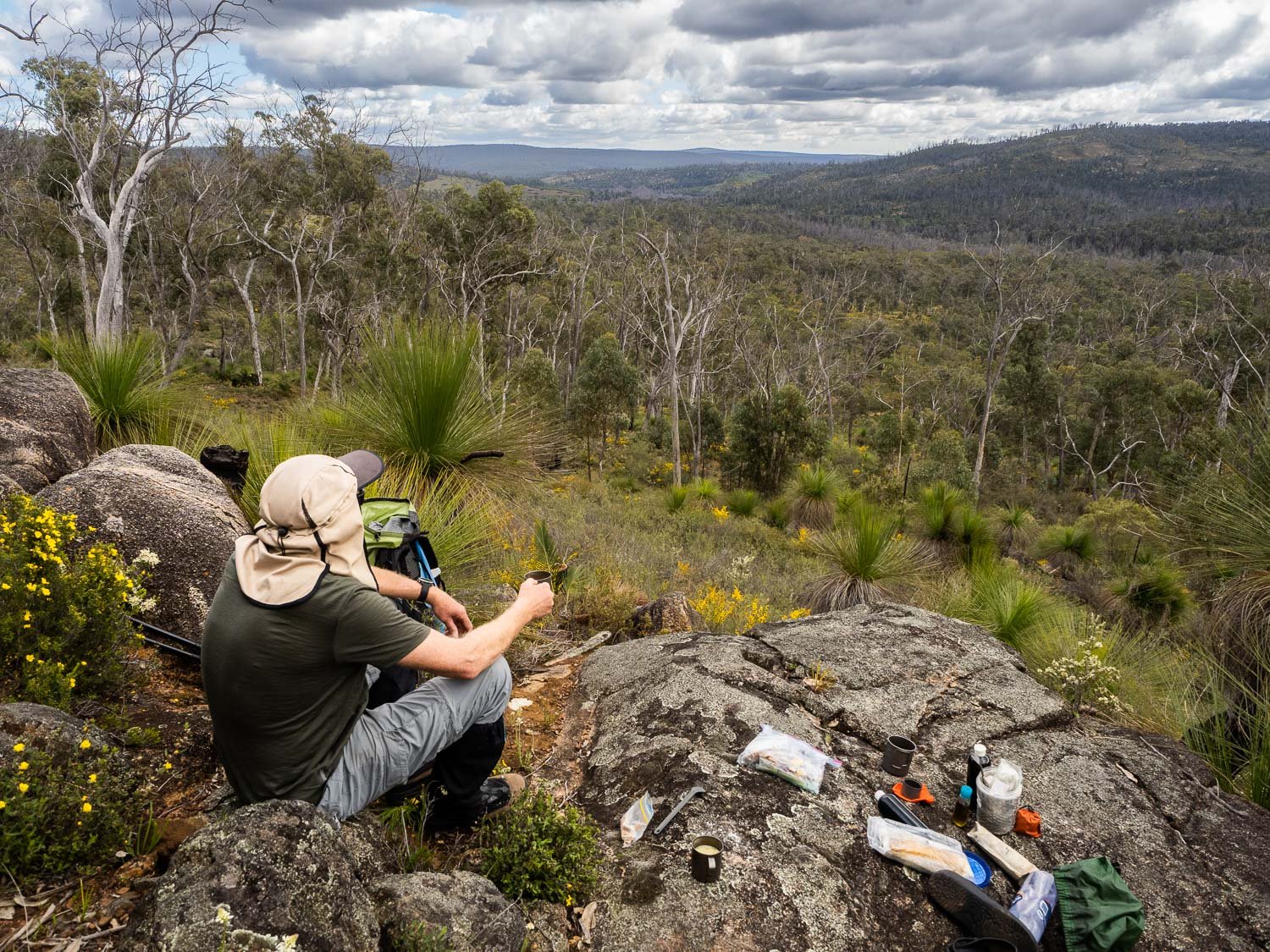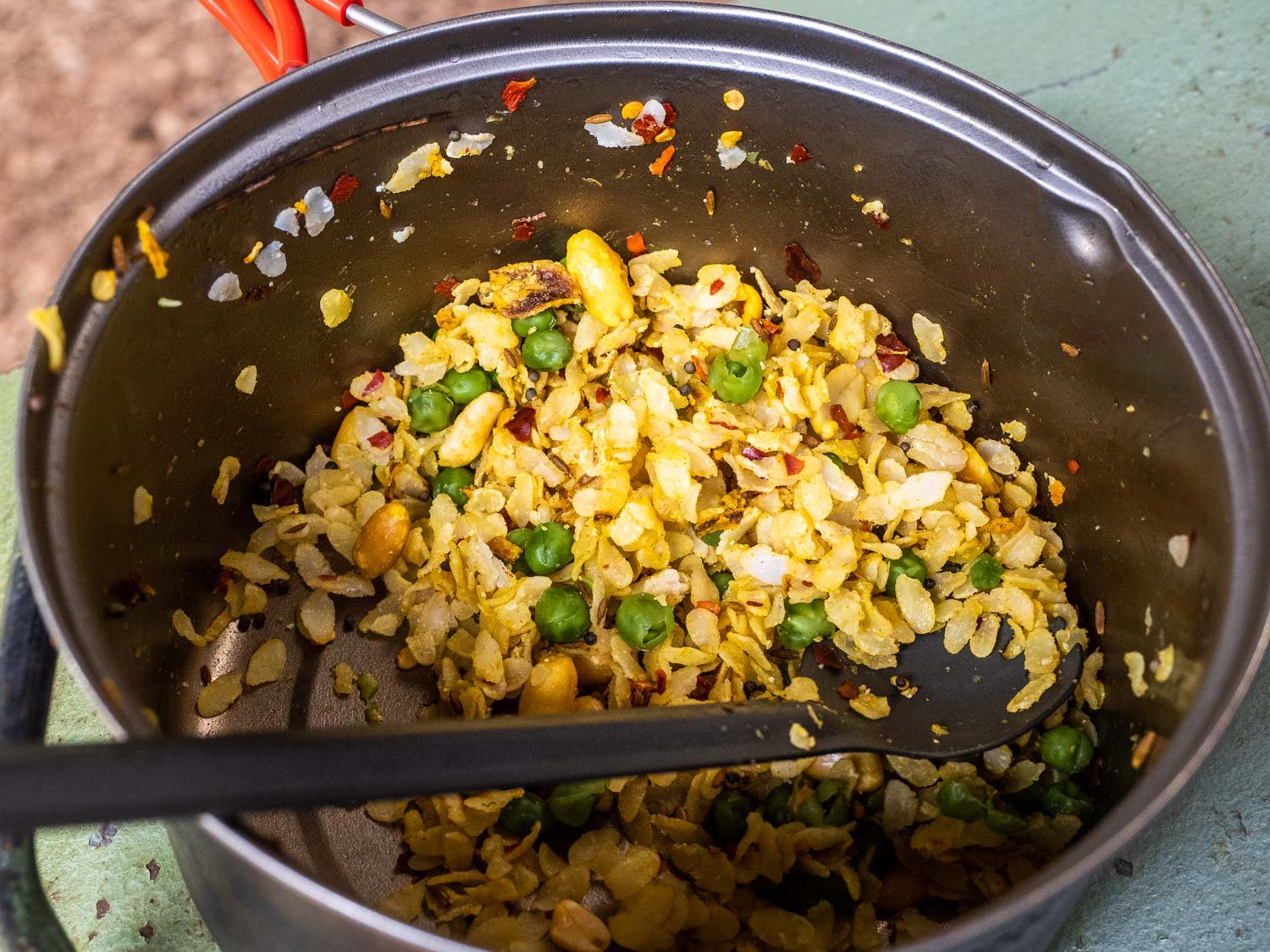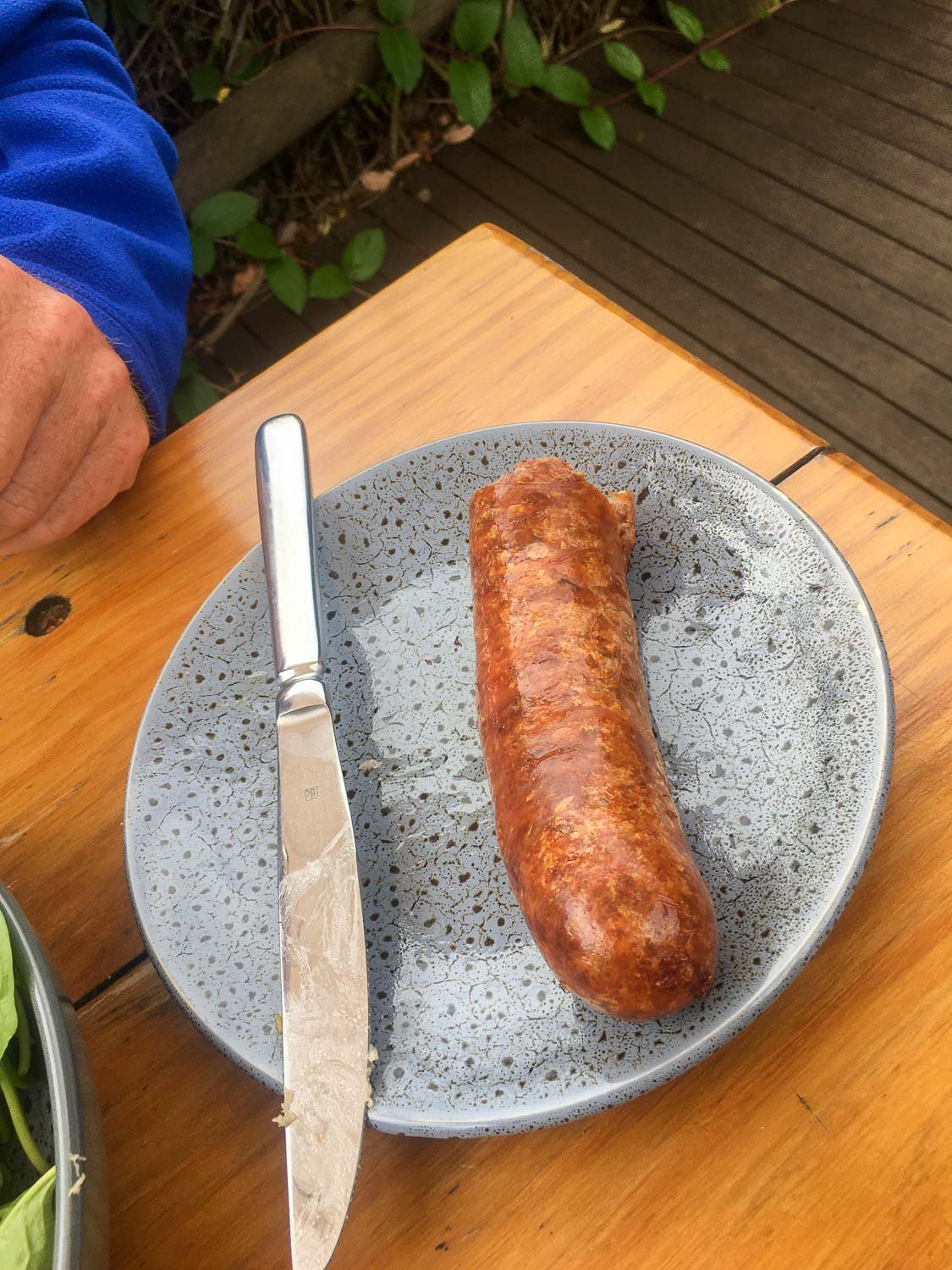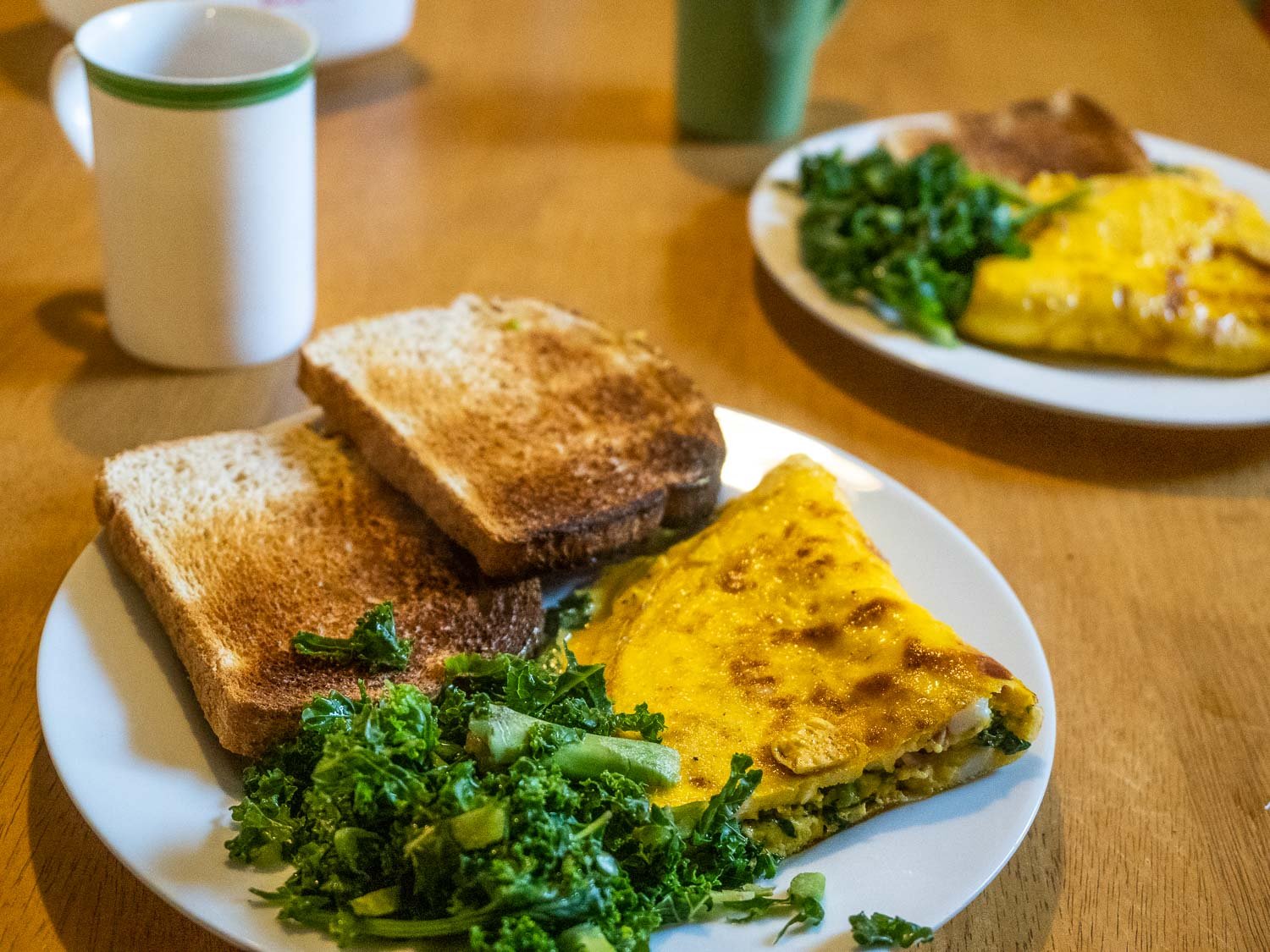Food for Thru-hiking the Bibbulmun Track
Meal Preparation, Logistics, Resupply and Storage on Long Distance Treks
Lunch with view - why not take the time to enjoy both?
Preparing and Selecting Food
There is no one right or wrong way to organise food for a long-distance hike, but three approaches are common.
Before you start, dehydrate as much as you can at home, such as dinners and lunch dips. Prepare and package breakfasts and snacks as well. Package the food for each section into a resupply box and post or drop one in each track town. This method is by far the cheapest and lightest option, because for a long-distance hike you need so many meals, and commercial freeze-dried meals are very expensive.
Wing it. Buy everything for each section in the town preceding it. Most towns have supermarkets or delis that stock mac n’cheese, couscous, instant rice, noodles and other dried foods that can be adapted, although some shops are limited. Many visitor centres in country Australian towns near popular hikes sell freeze dried meals. You’ll end up with a combination of hiker freeze dried meals, supermarket dehydrated ready-meals, cheese, salami, wraps, crackers – whatever you can get. This option is the most expensive and heaviest.
A combination method – dehydrate or pre-package food at home, and then supplement with town purchases, such as cheese and salami for lunch, muesli for breakfast, or a few commercial dehydrated meals for dinner.
We split this day in two and, with the beach walking done, took a small detour to Greens Pool for a snack and view. Delightful!
Although non-dehydrated foods are heavy, it’s possible for relaxed hikers to use them on shorter sections. Longer sections are trickier for us because we spend more days on the track than faster hikers. Therefore, if you plan to mix things up, reserve your dehydrated and lightest foods for the longest sections.
High salt and sugar supermarket ready meals such as mac n’cheese are convenient for short hikes, but subsisting on them and junk food for the 60-80 days (including 2-3 nights in each town) leisurely hikers will spend on the Bibbulmun, isn’t great for our health. Longer hikes over longer periods are even worse.
Quality commercial freeze dried or dehydrated Australian/New Zealand meals such as Feed the Hike, Strive and particularly Radix Nutrition are expensive but far more nutritious and tasty than cheaper brands. Check protein, fat and calorie content as they vary between meals.
Home Dehydrating
Wanting a variety of meals with good nutritional value, we dehydrated all our dinners and most of our lunches before our Bibbulmun hike. We recommend that, if budget is a high priority, you dehydrate at least some of your dinners. You can use an oven, or consider buying a dehydrator (they aren’t expensive, and you will recoup the money many times over). The Bibbulmun Track Foundation hires out dehydrators to all BTF members for a maximum period of a fortnight.
Cooking for two, I prepared and dehydrated batches of 8-12 serves (4-6 days) of 11 different dishes, once or twice a week during our preparation time rather than all at once at the end, so the task wasn’t too overwhelming.
Dehydrating your own food isn’t difficult. You’ll find numerous dehydrating recipes online, but it’s easier to adapt meals you normally cook at home, and these are often the best ones for you to take with you. We have all the information you need to prepare, adapt, cook, dehydrate and rehydrate your meals here, including a Cheat’s Hacks article for those who hate cooking!
Part of a huge batch of one of our favourite dehydrated dinners, macaroni bolognese, on the Excalibur dehydrator trays ready for dehydrating.
Dehydrating isn’t rocket science!
And here are our dinners dehydrated:
120 dehydrated dinner serves ready to go!
The Importance of Protein, Carbs and Fats
Although our home dehydrated food has always been fine for shorter hikes, after about seven weeks on the Bibbulmun we realised that the ratio of protein to carbs and fats, especially in our dinners and noodle breakfasts, was too low for a long-distance hike: Geoff lost muscle mass, and I didn’t gain as much strength as I should have (we’ve now tweaked our recipes). At this point, we ate more jerky and protein balls for snacks, plus more cheese, salami and tuna at lunch time.
We met hikers who supplemented with Radix Nutrition’s vegetable protein powder, a lightweight, efficient, sustainable alternative, and we will be taking it on future hikes: proper nutrition, as we discovered, makes a huge difference. Consulting a sports dietician to check our menu (which we have now tweaked to include extra protein!) would have been helpful. There are guides as to grams per kilo of bodyweight, or calories per day, or weight of foods per day, and frequency of consumption, but a consultation before you begin dehydrating ensures your diet is exactly appropriate for you and your hike.
Carrying a bottle of olive oil is helpful because dehydrated meals are so low in fat. Add the oil to dips, dehydrated feta, and dinners for taste, mouthfeel and calories, and include top up oil in your resupply boxes.
We also carry a tiny shaker of salt in our first aid kit mainly for leeches, but also for adding to various lunches (feta, dips).
Gear Skeptic has a wonderful series of long, in-depth and comprehensive videos on food weight, nutrition, meal planning and water treatment. We highly recommend them.
Breakfasts comprised
porridge: quick oats, sometimes mixed with steel cut oats, plus full cream milk powder
noodles and vegetables (we now add jerky, extra nuts or dried tofu to them to increase protein content); and
poha (rice flakes with nuts, peas, chili and Indian spices).
Other people ate: buckwheat, protein bars, muesli and bircher muesli, and commercial freeze dried options.
Our hiking version of Poha - a new hiking breakfast for us this trip
It added variety… and it tasted good as an unnamed greedy hiker* who couldn’t wait for the photo can confirm!
*Geoff
Lunches
As for many others, our first lunch (or two) out of town is usually salami or hard cheese with Geoff’s homemade sourdough crackers. We vac-seal these crackers before placing them in each food drop box, and they stayed crisp and delicious even after three months. Crackers are much, much lighter than wraps or bread, so consider replacing the latter particularly on longer sections to minimise pack weight.
From the second or third day out of town, we eat a variety of our lightweight lunch options. These include smoothies, or sourdough crackers with dips, tuna, soup or rehydrated freeze dried feta with a splash of olive oil (our favourite).
Our favourite light weight lunch:
Sourdough crackers and rehydrated feta with a little olive oil and salt - yum!
Our Dinners comprised
Potato and Leek Soup with Garlic Croutons
Cauliflower Cheese Mac
Pork and Bean Soup
Nutritious and tasty - not your average soup, more like a stew
Eleven different dinners provided great variety. Aim to eat the heaviest meals early in each section, whilst saving a favourite for a tough day. On the longest sections (such as Kalamunda to Brookton Highway, and Brookton Highway to Dwellingup on the Bibbulmun Track), we packed a selection of the lighter meals, with fewer heavier ones.
All long distance hikers pig out in towns to satisfy our protein and fat cravings. Nearly every town on the Bibbulmun and other popular long distance hikes has cafes and/or pubs serving delicious food with generous serving sizes (they know hiker appetites!).
Geoff gets his greens hit. Looks healthy… but what’s that on the plate on the side?
In towns there’s heathy greens…
and MEAT
Snacks and Drinks
We pre-package all daily snacks including muesli bars, protein balls and bars, dark chocolate, jelly snakes and lollies, vegie chips, dried fruit, nuts, dried fava beans and chickpeas, and homemade fruit leather. Additional high protein snacks purchased in towns during the last third of our Bibbulmun walk prevented Geoff losing more muscle mass.
We didn’t record the cost of the snacks we bought before the trip, but they were a significant expense, I would guess close to the expense of our dinners. People who home bake can save money by making their own protein bars. Home dried jerky is vastly cheaper than bought jerky and we will make this next time.
On other walks, we’ve carried drinking chocolate with milk powder, but this is heavy for a thru-hike, so we stuck to tea and cup a soup. These are of little nutritional value, but a warming soup or cuppa on a cold, wet, miserable day is priceless. We carry no alcohol, although I received a treat from Geoff on my birthday:
Happy Birthday Helen
Chocolate and Cognac - lasted surprisingly long in Geoff’s pack!
Food Drops and Resupply
For the Bibbulmun Track, we drove to Western Australia and dropped food boxes at town Visitor Centres, whose staff kept them safe for us to collect. We gave each centre a donation for their trouble: not required, but respectful. Dropping off food boxes in Bibbulmun Track towns worked for us because we drove but, if you’re flying from interstate, posting is the way to go.
If travelling from interstate, home cooked and dehydrated food is permitted in mail but be aware of WA’s very strict requirements covering other foodstuffs. Wherever you plan to hike interstate or overseas, check the state or country’s import rules before starting your food prep.
If you drop off boxes instead of mailing them, you can include fuel in the food boxes, as well as the usual maps, medication, sunscreen and toiletry replacements such as toothpaste and toilet paper.
Some long distance hikes, such as the Australian Alps Walking Track in eastern Australia, require food drops in secure vermin and weatherproof caches in bushland. Other multiday hikes, such as the Larapinta in central Australia, have track transfer companies who drop food for you at storage facilities along the track.
For extremely long thru-hikes such as the PCT, CDT and AT in the US, postage is the only sensible option. Conversely, thru-hikes such as the Alta Vies in Europe have closely spaced towns and rifugias: although you could post to a few towns, you won’t need to carry ten days of food at a time, so a mix of dehydrated and fresh foods is much more feasible.
Checking and organising food from a resupply box in our motel room
Include spare meals for one day for each section of track in case of delays. We put unused ones into our bounce boxes.
The food drops took a couple of days, and we left our car at Perth Airport.
Denmark, the only town with a visitor centre that was closed at the time we passed through, has Trail Angels who may be able to store your box for you.
A very focused Geoff preparing breakfast
Noodles, poha or porridge... but what about the view?
Additional Food Drop Points for Leisurely Hikers
When you hike slowly, such as we do, staying in every hut, and sometimes between huts as well, the longest time between Bibbulmun towns is about ten days, except for the northernmost section of around 18 days with a midway food drop at Brookton Highway. This means that we more leisurely folk need to carry more days of food for each section than faster hikers, many of whom double hut. With two people sharing gear, it was manageable, but you may prefer to organise different or additional food drops, the most convenient being:
Dale Road Access Point (between Kalamunda and Brookton Highway)
North Banister (between Brookton Highway and Dwellingup)
Sullivan’s Rock (between Brookton Highway and Dwellingup), or
at another track access point where you can arrange a pickup.
Bear in mind that Brookton Highway is the only widely used official non-town food drop spot: you reach it after your first eight days of hiking when travelling SOBO (southbound).
Other extra food drop points worth considering further along the hike include:
Harvey-Quindanning Road access point (between Dwellingup and Collie)
Donnelly Village (between Balingup and Pemberton)
Northcliffe (between Pemberton and Walpole) - do this one!
Peaceful Bay (between Walpole and Denmark)
We didn’t organise a food resupply at Donnelly River Village…
But we did buy some goose eggs and fresh greens from the General Store and whipped up a goose egg omelette for breakfast - what a treat that was!
Some of these additional food drops between towns need to be organised with Track Angels (see the Bibbulmun Track facebook page for names), or for a reasonable fee with local transport and track transfer operators. They will meet you at an agreed time, or place your box behind a tree on the day you plan to arrive.
Pack Weight Benefits from Extra Food Drops
We work on avoiding days that we exceed 95% of our comfortable maximum pack weight and minimising days over 90%. For us, that combined pack weight is 27 kg – you might also like to check our posts load sharing for two and how to plan a slower hike for why and how we do this.
For the Bibbulmun, we used seven resupply points which were mostly towns and under that arrangement we had six days (out of 62 days walking) where we were just over 95 % of our capacity, and 19 days over 90%. If instead, we had used 12 resupply points – all at easily arranged points – as per our above list - and discussed in detail in our posts on planning and tips for a leisurely Bibbulmun hike and 7 ways to make the longer days easier - we would not have exceeded 95% of our capacity on any day and had only 5 days where we would exceed 90% of our capacity. You can see that the benefits of extra food drops are substantial, and we’d advise that you seriously consider these options, particularly if you are hiking solo and/or have limited weight carrying flexibility. Still not sure? If we did it again we would - or see Benefits from Extra Food Drops on Pack Weights for more information.
Cooking on the Track
Campfires (occasionally there is even cut wood and an axe!) are allowed at certain times of year at some Bibbulmun huts but not all, particularly in the south. Bring a fuel stove, not least because finding dry wood to cook over a fire in bucketing rain just doesn’t work.
Dinner around the campfire.
This was a real treat where allowed in the northern part of the hike.
Campfires are banned in many Australian National Parks and Reserves, and throughout the summer months everywhere. In some countries, there are restrictions on the kind of fuel stove you may use, so check ahead of time.
In Your Pack
Some people package food for each day - breakfast, snacks, lunches and dinner - into individual bags. We prefer to pack breakfasts together in one bag, lunches in another, dinners in a third and snacks in a fourth. We consolidate these partway between resupplies, such as by placing the smaller snack bag into the now emptier dinner bag.
Each morning, when packing up the breakfast things, we take out the snacks and lunch for that day, and place them in a side pocket or near the top of the pack (depending on weather).
Storing Food Overnight in Camp
Because hikers have generally been very good at storing their food correctly in Bibbulmun huts, native animals such as possums and bush rats haven’t been attracted as much as on other tracks like the Overland, and are less of a problem. But you can bet that at every hut there is at least one clever little animal who will find your food if you leave it on the table or even in your pack leaning against the wall. They will chew through pockets to get at anything remotely edible: if you’ve stored aromatic snacks in pack pockets during the day, unzip them! And not only food: native rodents have been known to chew through packs to get at lip balm, moisturiser and toothpaste!
Although a few Bibbulmun huts with particularly determined critters have heavy duty plastic storage boxes for your food, we recommend a lightweight carabiner with spectra or strong fishing line plus ultrasil food bags to suspend from roof beams out of reach of animals.
We do this at every Australian campsite as a matter of course – by the time you discover the theft in the morning, it’s too late! And of course, in the US there are bears to contend with, and a whole new set of requirements.
Multivitamins
Neither of us take multivitamins at home but we did on the Bibbulmun because we ate few fresh fruit and vegetables. We both craved salads and big hunks of flesh when we reached towns – it’s amazing how clearly your body tells you what it needs!
However you decide to organise your food – home dehydrated, commercial, a random selection of foods as you go or a combination of all three, spend a little time calculating how much you need for each day, rather than just throwing stuff in and hoping it’s about right. If you plan at least to day level, you’ll know you won’t go hungry, nor be carrying excess weight: you’ll be amazed what those random bags of snacks add up to! However, it’s worth carrying one extra day’s worth of food in each section in case of an unforeseen delay.
Top of Mount Vincent - another excellent spot for lunch
And remember, whilst you’ll encounter the usual bush hazards, the Bibbulmun Track is not an extreme environment so, even if you miscalculate, you won’t be holed up in a blizzard for days, and there is water at every campsite. You won’t die from starvation between towns! If you haven’t planned meals for a hike before, just give it a go – you’ll fine tune as the weeks go by and, by the end, you’ll be a pro!
















